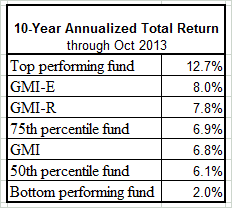The last five years have been anything but typical for financial markets, primarily because macroeconomic conditions around the world have been conspicuously abnormal. From heightened uncertainty about economic growth to extraordinary monetary policies, there’s no shortage of reasons to argue that much has changed since the world flirted with meltdown in late-2008. Five years after looking into the abyss, and living to tell the tale, it’s reasonable to ask: Has recent history helped or hindered our efforts to design and manage multi-asset class portfolios?
You won’t have any trouble finding money managers and individual investors who answer in the affirmative. The basic argument runs like this: Higher market volatility and greater economic uncertainty create opportunity for clever investors. If true, the evidence at this late date should be clear and compelling. But when we study the track records of actively managed asset allocation strategies, the numbers suggest that nothing much has changed.
A simple strategy of diversifying across the major asset classes, based on market-value weights, continues to deliver above-average returns. Naively rebalancing the mix at the end of each calendar year does a bit better. Equally weighting the asset classes and rebalancing back to equal weights every December 31 does better still. How does this trio of forecast-free strategies compare with the wider world of professionally managed asset allocation products? The short answer is that it’s tough to beat broadly diversified passive and quasi-passive asset allocation strategies. This is old news, and for well-known reasons, although in some circles it’s radical information, in part because it’s rarely discussed. But the truth will set you free, or at least open your mind to the basic facts about the main drivers of risk premia.
With that in mind, let’s update a semi-regular feature on these pages: comparing a proprietary trio of asset allocation benchmarks to a broad spectrum of mutual funds that engage in some aspect of managing multi-asset class portfolios. First, let’s define the three benchmarks:
• Global Market Index (GMI), an unmanaged market-value weighted mix of all the major asset classes
• Global Market Index Rebalanced (GMI-R), a market-value weighted mix of all the major asset classes that’s rebalanced back to market weights every December 31
• Global Market Index Equal Weight (GMI-E), an equally weighted mix of all the major asset classes that rebalanced back to equal weights every December 31
Now let’s compare these three benchmarks to nearly 1,200 multi-asset class mutual funds with at least 10 years of performance history as of October 31, 2013, based on data in Morningstar Principia software. These funds run the gamut, from simple balanced strategies to hedge fund equivalents and everything in between. The chart below summarizes the big picture results:
Here’s how the trailing 10-year annualized returns stack up:
The basic result isn’t terribly surprising or all that different from when I crunched the numbers earlier this year. GMI’s performance is just below the 75th percentile relative to 1,164 actively managed asset allocation funds. GMI-R’s record is a bit better, and GMI-E’s is better still.
How can naïve asset allocation strategies deliver competitive results against a broad swath of professional money managers? For all the usual reasons, starting with the simple fact that alpha–benchmark-beating performance–is always a zero-sum game. Everyone’s fishing in the same waters and so there’s only so much positive alpha to go around. For everyone who beats the odds (either with talent or luck), there’s someone who suffers. Positive alpha must be financed with negative alpha. Meantime, a reasonably designed benchmark will always end up with average to above-average results.
Why above-average results? Because trying to beat a robust benchmark is costly. Between trading fees, taxes, and other frictions, active management is expensive. Some managers are better than others at controlling costs, but overall this is a headwind that usually takes a heavy toll on results.
As usual when I present these results I roll out the standard caveat that the data above doesn’t mean that we should abandon active management in the design and oversight of asset allocation. There are good reasons for customizing an asset allocation strategy. But the numbers strongly suggest that we should be wary of assuming that it’s easy to beat Mr. Market’s asset allocation strategy. Marketing hype and the news of the day tend to suggest otherwise, but a sober analysis on the data is a powerful reminder that trying too hard is a costly affair in the money game.

